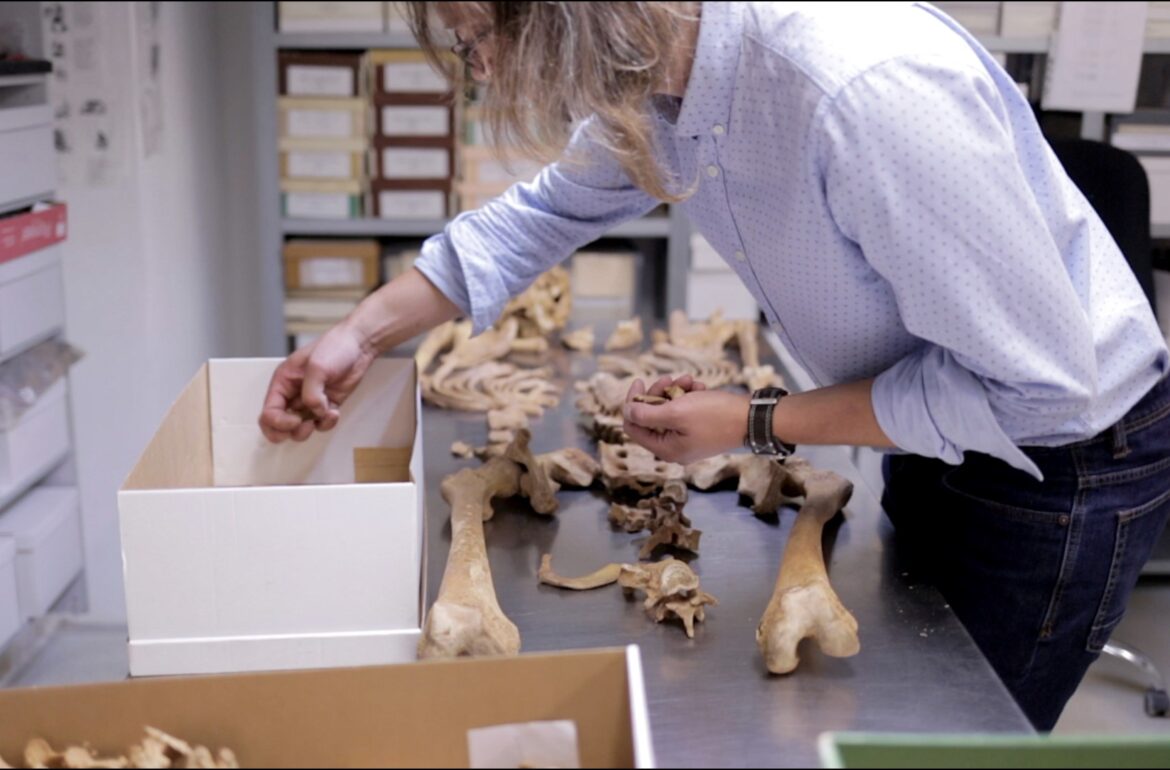Finding a skeleton in the ground may be a horrifying experience for a common citizen, but it is a real treat for an ardent bone explorer to understand the past. Martin Malve, who works as a specialist at the University of Tartu Chair of Archaeology, recently found extraordinary skeletons on excavations.
How would you rate the excavations that took place in Rakvere?
We don’t usually see into the ground, and so we didn’t expect to reach the cemetery of the executed. I work as an osteologist and for me, these excavations were a true highlight. Of course, the rest of the skeletons at the churchyard cannot be set aside. A half-kilometre long central heating route was installed on Pikk Street, and my section was the garden of the Church of St. Michael. The field clerk thought there was no cemetery, but 20 years ago they found bones during the excavations there. We found 57 burials from the St. Michael’s churchyard. Several hundred metres away, right under the pavement, the skeletons of the executed persons were unearthed. In total, we found five skeletons, of which two were from the churchyard of the Church of St. Michael, and three from the cemetery of the executed.
So, in total there were five skeletons?
In total, five skeletons belonging to violently killed people were found, three of them were executed, and two fell in battle. Since the findings were gathered from several different sites, the results of the fieldwork still need further research.
And this was a place of execution?
That’s right. If we go back to the Middle Ages and earlier times, the dead were buried either at the Gallows hill or just beside it. From 1648, for example, there is a description from Tartu, where one person committed suicide, after which the executioner took his body and dragged it around the city with a cart. The body had to be desecrated because according to Christian customs, suicide is the worst thing a man can do. The executioner displayed the body all around town, drove out to the place of execution, and buried it there. Similarly, the dead were buried at the execution sites.
In Estonia, the only gallows hill that was almost entirely excavated is located in Tallinn; it is under Swedbank’s building on Liivalaia Street. More than a hundred skeletons were unearthed of which I have examined all the skulls, but only one of the skulls shows signs the man was killed by a sword. Beheading with a sword was reserved only for people of high social status, as ordinary criminals were hanged.
Does that mean you found another execution site in Estonia?
We actually know more of these sites, but only three Gallows sites have been excavated and explored. The first fieldwork was carried out in 1932 at Haapsalu. The local newspaper, Lääne Elu, which was the most yellow tabloid in Estonia, wrote that the elders of the executed Estonians were found. It brutally described how their heads and legs were cut off. We also excavated there in 2013–14 to determine if there really were executed people buried there and the conclusion was no. In addition, we know the gallows tree in Viljandi, but this is situated on the hill of the present day cemetery and that is why it is not possible to carry out fieldwork there. We also know a gallows tree in Lihula.
What more can be said about skeletons you found in Rakvere?
It’s difficult to say because they were executed and didn’t have any grave goods. They were buried according to the Christian customs, most of them were facing east so they could see Christ resurrected in the East on Doomsday and rise together. One of the dead was buried in a way that his severed head was placed on his left knee. If we look at Scandinavia or Britain, for example, this has been a tradition that shows contempt for the dead. Placing someone’s head in another place was done on purpose to ruin the possibility of resurrection.
My colleagues and historians have suggested that this man must have been particularly bad because his head was put on his feet. His burial period is difficult to estimate because there are no items on the burial. Thus, we can say that the executed person is from between 1250 and 1750, or a period of 500 years, which is quite a long time. We know that the witch hunt took place in Europe between the 16th and17th centuries, and those executed may belong to the same period.
What new information do these findings add to our history?
It was a rare and outstanding find. The last time executed people were excavated was during the early 90s on Tallinn’s gallows hill, and since then, men who died in battle have also been found. It is now possible to examine these executed men and women more closely. In Rakvere, for example, all three executed men were young and possibly criminals. It gives us more information and confirms the general understanding that the executed were not buried in the graveyards, but further away. In the Middle Ages and earlier times, towns had separate places for execution and burial. From Tallinn, we know at least three or four of them.
I suppose there must have been a specific reason for executing someone?
Because they’ve been executed by a sword, it’s certain that these are not ordinary people. There are many possibilities. It is possible that they were enemy soldiers who have been fighting a war and were captured, or they have been the messengers of the enemies and were killed. All options are currently available for analysis.
What else can be learned about these skeletons?
A more in-depth investigation is still underway since we’ve just finished the fieldwork and we really can’t tell the age ranges at the moment of death. During the excavations, we initially marked down 20–50 years of life on record, although we hope it will be specified in the lab. We would also like to find information about other pathologies: how they lived, whether they had any other injuries and what they ate. Caries and tartar give us hints about what they ate, fractures and joint wear provide additional information about the lifestyle and activity of the people from the Middle Ages. When we started work in the churchyard, we unearthed 57 burials. Of those people, two were men with violent injuries, especially one of the men who had numerous cut marks.
The man mentioned had no teeth on one side of his face and a piece of jawbone was missing because of a massive blow with a sword. In addition, this skeleton had a series of cut marks on the neck, head and body. This is a sign of the brutality of combat, where blows can come from all sides. I’ve been looking at skeletons that are likely to come from the battleground and there is no way they’ve fallen by a single blow. There are also skeletons with three or four cut marks and one has a hole from an arrow.
These skeletons certainly show one aspect that is visibly clear and direct: we see the battle situation, the injuries and the various weapons that have been used. In the case of the two burials in the churchyard in Rakvere, one of the skulls originated from the 13th –14th centuries, being the first half of the Middle Ages. According to this, he was certainly part of the local community and was not a criminal but rather a fallen warrior because he was buried in the churchyard. In addition to these two violently executed men, there are also women and children buried there. We find out about their health, how they lived and what diseases they had.
How long can a skeleton be preserved in the ground?
Our ancestors’ bones, which have been fossilized during hundreds of thousands of years, are being excavated in Africa, so bones can be preserved in the ground forever. Estonia’s oldest human remains discovered are about 8,500 years old, but there are also considerably earlier findings from elsewhere in the world. In that sense, human bones can be well preserved. There are also regions in Estonia where they are in acidic sands and are thus poorly maintained, so they tend to disintegrate within a couple of hundred years. In Southern Estonia, for example, and around Valga, there are places where bones are not preserved very well. But otherwise, bones will be preserved in Estonia for almost 10,000 years at least, so we have material to explore.
Written by Sven Paulus.
This article was funded by the European Regional Development Fund through Estonian Research Council.
 Back
Back



